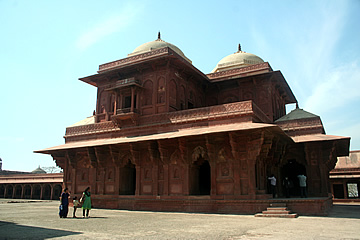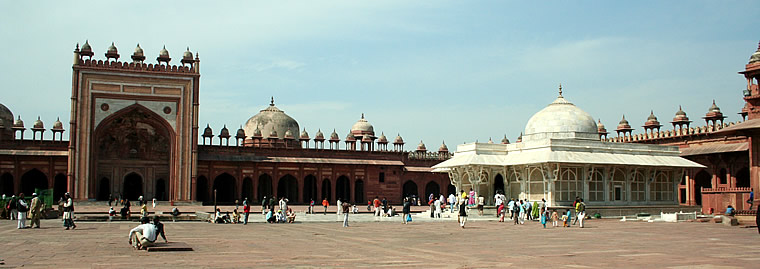

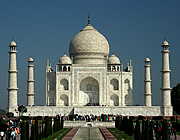
In February 2009 we travelled to India and saw so much that the account for this holiday is split into several articles.
This is the first part covering Delhi, Agra and Fatehpur Sikri, from centuries old bazaars to colonial New Delhi and the magnificent Taj Mahal.
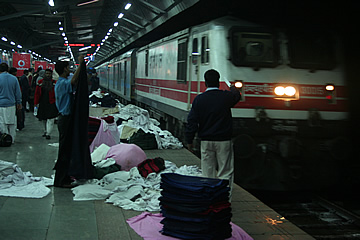
This was a tailor-made holiday so we had a car, driver and guide throughout our time in India. At 5a.m. we were collected by our rep, car and driver and taken to Delhi Railway Station for the Express Train to Agra (Utar Pradesh). Outside the station was teeming with people and cars, the usual traffic mayhem and noise, though it was still dark. The station has a huge entrance hall and lots of people were bundled up and sleeping on the floor. There was a security check at the entrance to the platform - pratically everyone caused it to beep but we saw nobody body-checked - it would have caused huge delays to check everyone, I suppose.
On the platform there were huge piles of linen and blankets, probably from a night train. Our train left on time - our TransIndus rep making sure we were well-settled before leaving us. We had first class reserved seats and these were fine. The rep had warned us, and there were frequent announcements on the train, that people should keep an eye on their luggage. As we departed sealed bottles of mineral water were handed out, then breakfast of tea and biscuits, later spicy rissoles, bread and jam.
Scenes from the train: tall chimneys (I think brick kilns), very poor housing - most brick but some shanty-like settlements of tarpaulin tents, the usual crowded small settlements of houses set in dirt and rubble; the bright orange sun rising over the misty fields; circular huts with a conical roofs, all made from long twigs or rushes and look agricultural; a monkey running along a long wall; a woman in a burnt orange sari herding goats with a stick in a field.
We arrived in Agra half an hour late but our rep and car were waiting with the driver who accompanied us for the rest of the holiday. His name was Ramkesh Neema and, though he spoke only a little English, he was an excellent driver. At one time he had driven a passenger jeep - we saw many of these in Agra absolutely stuffed with people.
We went straight to the Clark's Shiraz and though very early we had a only a short wait while our room was made ready, drinking tea in the restaurant. In India we invariably drank tea, Darjeeling or Assam, black without sugar.
Our room in the hotel was very nice, large, nicely furnished and modern. Though this is one of the two oldest hotels in Agra there isn't really any Indian character to the bedrooms and you could be anywhere. However, the restaurant is excellent: great food and very good Indian musicians, and the Taj Mahal and fort are visible from the restaurant and roof terrace - at least the main dome of the Taj Mahal is visible!
There were lots of cows in the streets of Agra - more than we'd seen in Delhi - also black buffalo. Apparently all cows belong to someone and they just wander around most of the day eating what they can - sometimes they eat plastic bags in which food has been dumped and this can kill them. Also lots of carts drawn by pairs of bullocks and also one very sad-looking elephant. Again here there are very poor-looking dwellings and people. Everywhere we go the people smile and say hello.
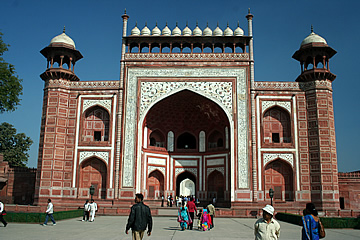
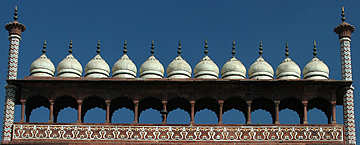
The main reason for coming to Agra is, of course, the Taj Mahal. In a way I was fully prepared to be disappointed - many very famous buildings just don't match the hype and photographs. I need not have been concerned: this is the most stunningly beautiful building I have every seen. It is huge but looks so light. The craftsmanship in the inlaid marble work and carving is unbelievable. I was really so impressed - it is magnificent.
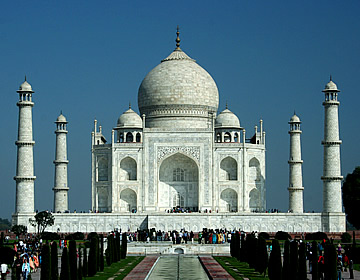
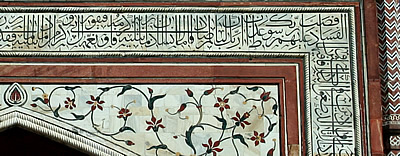
The Taj Mahal is a tomb, built by the Emperor Shah Jahan for his favourite wife Mumtaz Mahal, who died in 1431 aged 39 after the birth of their fourteenth child. It is made of the hardest marble in India and took 22 years to complete - symbolised by the 22 Mughal canopies, in two rows of 11, on the roof of the entrance gate. Islamic script on the gate is scaled in height so that the script at the top appears to be the same height as the script at the bottom.

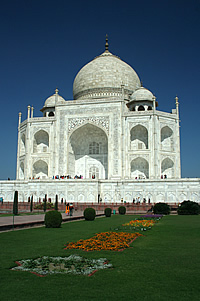
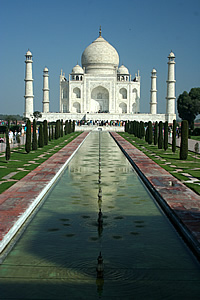
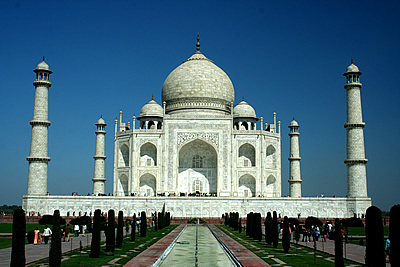
Once through the gate you get your first view of the mausoleum and it is unforgettable. It is set in an Islamic style "Garden of Paradise" with fountains, waterways, lawns and flower beds and behind flows the River Yamuna. The four graceful minarets at the corners of the Taj are tilted slightly outwards so that they would fall away from the Taj Mahal in an earthquake.
On the west is a domed mosque and an identical building is seen on the east side, said once to house visitors: it is also said that the British allowed favoured honeymoon couples to stay here - the ultimate romantic honeymoon! The British are also responsible for the rings in the dome - these were used to fix camouflage in place during the Second World War - how awful to think it might have been bombed!
Shoes must be removed before climbing on to the marble platform on which the Taj Mahal stands. Close viewing allows the magnificent workmanship to be appreciated.
Amazing carved flowers on huge sheets of marble - one mistake meant the whole sheet was discarded and work had to begin again.
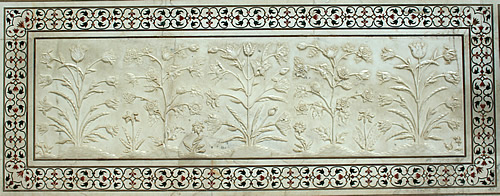

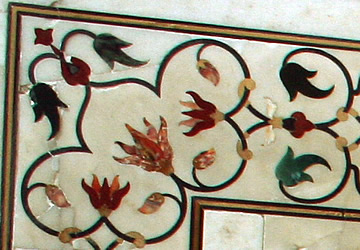
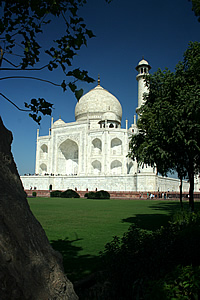
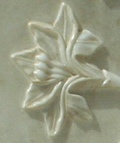
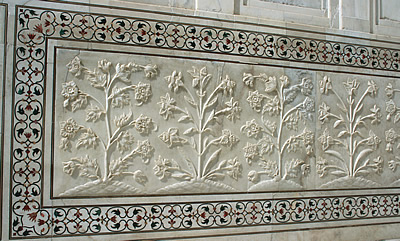
Similarly the patterns in petra dura (inlaid marble) are just stunning. Semi-precious stones are inlaid into the patterns: amethyst, coral, lapis lazuli, cornelian, turquoise, jade, brought from all over the world. Apparently some designs can no longer be created as a single design belongs to one family and dies with them if there are no male heirs - designs were not passed to daughters who would, of course, marry outside the family. Inside, our guide demonstrated the translucency of the marble and inlaid cornelian which glow when illuminated.
In an effort to protect this beautiful building from pollution, the result of which is sulphuric acid which attacks the marble causing it to yellow and flake, there is an industrial and vehicle exclusion zone around this area.

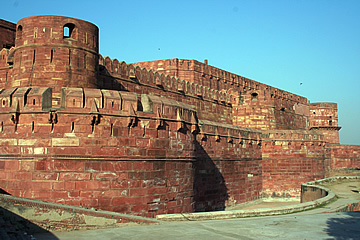
The fort was begun by Emperor Akbar in 1565, most of the palace buildings added by his grandson Shah Jahan, and completed with ramparts by his great-grandson Aurangzeb. The high red sandstone walls are punctuated by huge gates, of which only the southern Amar Singh Pol is now open.
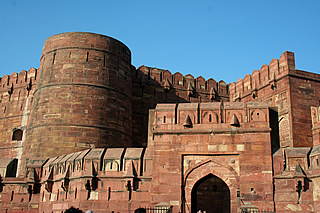
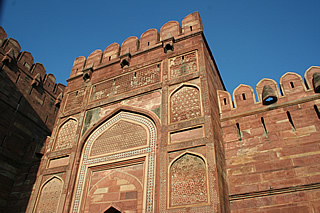
Entering the fort through the Amar Singh Pol there are many monkeys, apparently they can be quite aggressive if they think you have food. The gate is double-walled - as is the perimeter wall of the fort - and staggered as a defensive tactic to slow down invaders. Inside the gate the upper walls are pierced by stone lattice work where the ladies of the palace would look to see the Emperor returning, without themselves being seen.
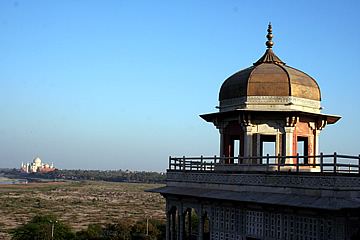
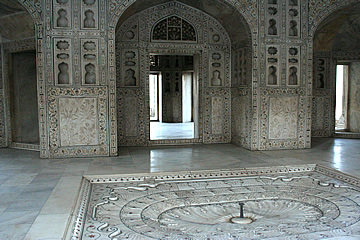
In 1657 Shah Jahan became ill and his son, Aurangzeb, seized power. Though he recovered his health to a certain degree, the Shah was deposed from power and imprisoned in the fort until he died 8 years later. From the fort he would have been able to see the Taj Mahal, where eventually his body was laid to rest beside his beloved wife. Originally, it is said, he wanted to build an identical Taj Mahal across the river, but this one would have been in black marble and for himself. The two were to be connected by a silver bridge. Gardens and foundations can actually be seen on the opposite bank of the river from the Taj Mahal.
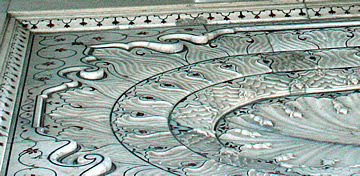
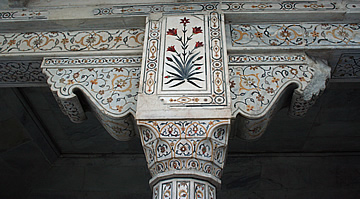
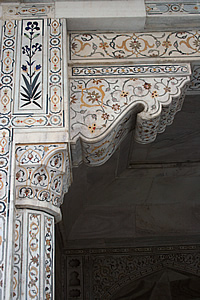
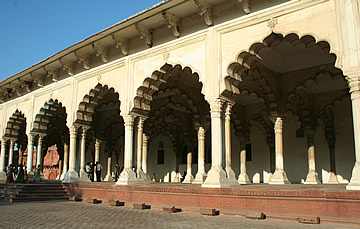
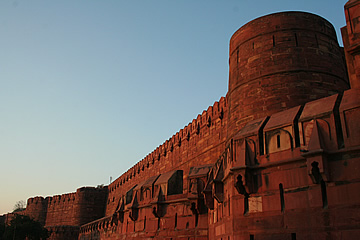
There is much to see here, though access to some parts, including the celebrated Pearl Mosque, is restricted. The Diwan-i-Am is an elegant pillared hall, once carpeted and hung with draperies - heavy in winter and lighter to move in the breeze in summer. Once it held the magnificent jewel-encrusted peacock throne which was moved to Delhi by Shah Jahan and then looted by the Persians.

There is a courtyard which housed shops, goods being brought to the ladies of the court to inspect. They would sit behind latticed screens so that they could not be seen by the merchants. Nearby is the Nagina Msjid - the Gem Mosque - made of marble and also for the use of the ladies. The Diwan-i-Khas was lavishly decorated for the receival of visiting dignitaries.
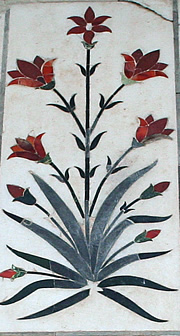
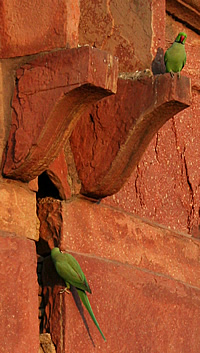
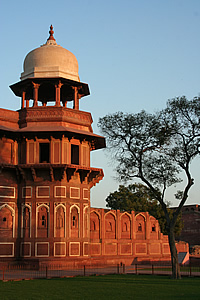
Further on are the white marble aparments with an octagonal tower where Shah Jahan spent the final years of his life, cared for by his daughter Jahanara, and the Shish Mahal - the Palace of Mirrors.
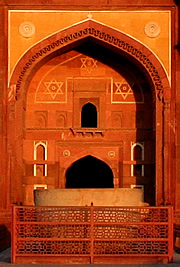
Finally there is the Hindustani palace built by Akbar for the pleasure of his son Jahangir with an enormous marble bath tub in the courtyard.
As we left the fort the sun was very low and the walls glowed a beautiful deep red.
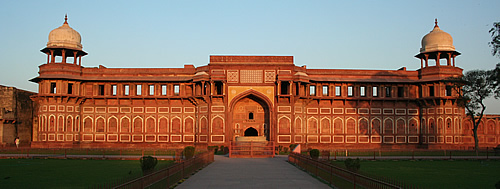
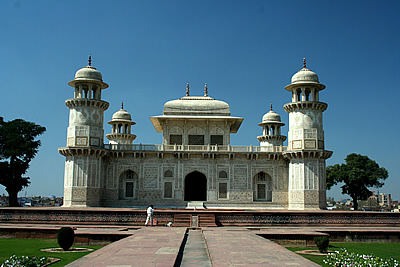
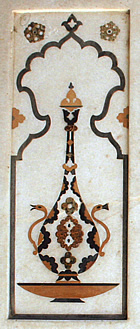
This exquisite little tomb is also known as "Baby Taj" for obvious reasons. It stands on the east bank of the river and is the resting place of Mirza Ghiyath Beg, an important courtier to Akbar and father-in-law to Jahangir.
Though small it is beautifully proportioned in white marble, again incorporating wonderful petra dura.
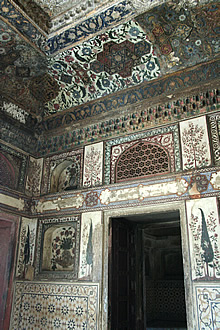
The tomb was actually designed by his daughter, Nur Jahan, and her mother is also buried there. The interior was obviously originally beautifully painted. Unfortunately this paintwork is deteriorating but it is still possible to imagine how colourful it must once have been.
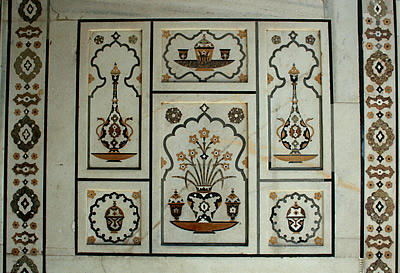
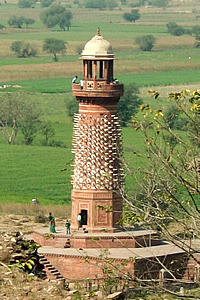
Called a ghost city, very little remains of this once extensive capital of Akbar apart from the Royal palace. Extensive restoration work was carried out by British archaeologists before independence.
About an hour's drive from Agra the scenes from the car wndow are endlessly fascinating: black buffalo wandering to their morning watering hole; four youngsters on a motorbike - no helmets, big smiles; a mother in her sari preparing two young children in blue school unifrom for school in the yard of a house; a bullock/goat market with large numbers of animals - 25000 rupees for a healthy bullock; women in colourful saris working in the fields or preparing dung disks for fuel - we saw piles and piles of these; a house which was simply a straw roof on props with a string bed and hanging cloth for a dividing wall; a young girl vigourously pumping water into gallon plastic containers.
The palace complex is reached by a short bus ride from the parking area. Fom the palace walls near the entrance can be seen a strange tower studded with white tusks - this is the Hiran Minar, said to have been built by Akbar to commemorate a favourite elephant.
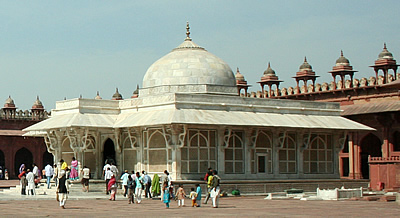
Desperate for a son, Akbar walked barefoot from Agra to where the saint Shaikh Salim Chishti lived at this spot. He was blessed with three sons and built Fatehpur Sikri to honour Shaikh Salim Chishti. A great spiritual reason to construct a city but not very practical - the area is very dry and water shortages caused the city to be abandoned early in the eighteenth century.
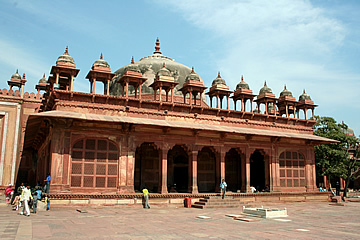
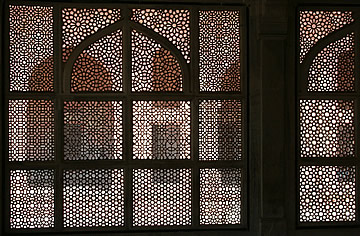
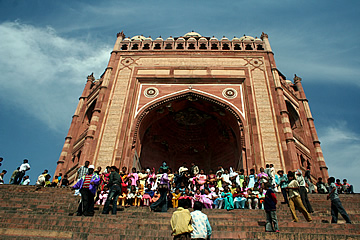
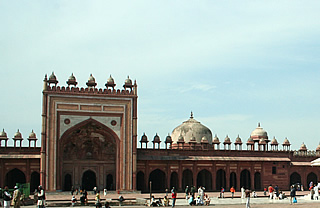
The tomb of Shaikh Salim Chishti (1581) lies in the huge courtyard of the Jami Masjid (mosque) (1571), just within the Buland Darwaza. Originally built in red sandstone, later faced with marble. The white marble tomb is very beautiful with exquisite lattice marble panels. Each panel is made from a single sheet of marble.
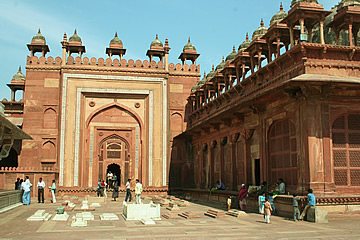
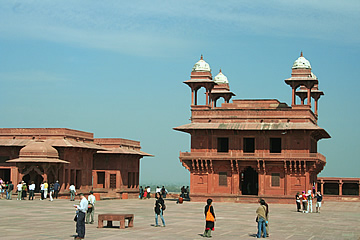
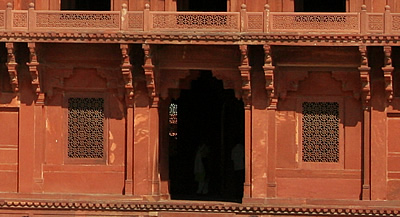
The huge Victory Gate, Buland Darwaza, was built to celebrate Akbar's victory over Gujarat.
Akbar was keen to understand and discuss the different religions and an unusual structure in the Diwan-i-Khas, known as the throne pillar, was built specifically to promote theological discussion. It consists of a raised throne connected to a gallery by four bridges where representatives of various religions would sit. It's a fascinating place and speaks volumes for Akbar's religious interest and tolerance.
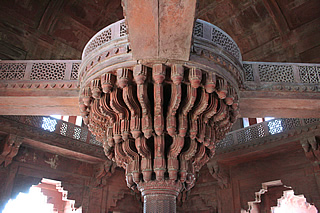
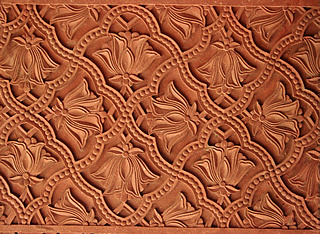
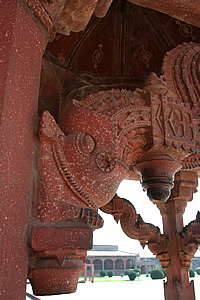
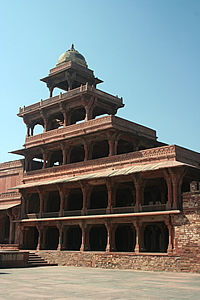
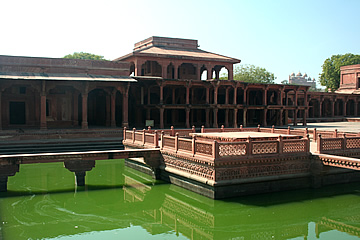
In the large courtyard a board game is set out for Pachisi to be played with slave girls as the pieces. Also in this courtyard is the eye-catching Panch Mahal: a five storeyed building which graduates from a wide base to a single canopied space at the top.
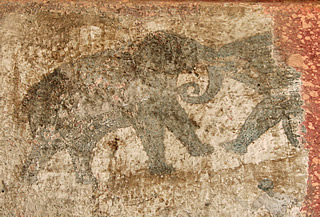
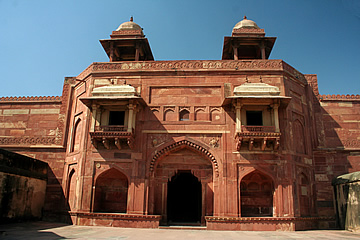
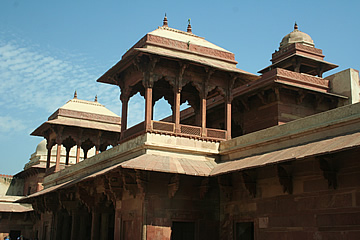
The complex includes three different palaces for his three favourite wives: a Hindu from Rajasthan, a Moslem from Turkey and a Christian from Portugal.
In front of Akbar's private apartments (Khawabgah) is the peerless pool or Anup Talao. A central platform is connected to the perimeter by four causeways, mirroring the pillar throne arrangement. Akbar is said to have sat here, surrounded by perfumed water.
The Haram Sara - Imperial Harem - covered a large area of the complex and included three palaces: the Rajput Princess of Amber Jodhbai's palace with beautiful Mughal canopied balconies, Birbal's Palace - apparently Birbal was Akbar's favourite courtier so it's unlikely this is its true name, and Sunahra Makan - the now rather plain Golden House. This last could have been the home of Akbar's mother or of one of his wives and once had golden paintings, long gone.
